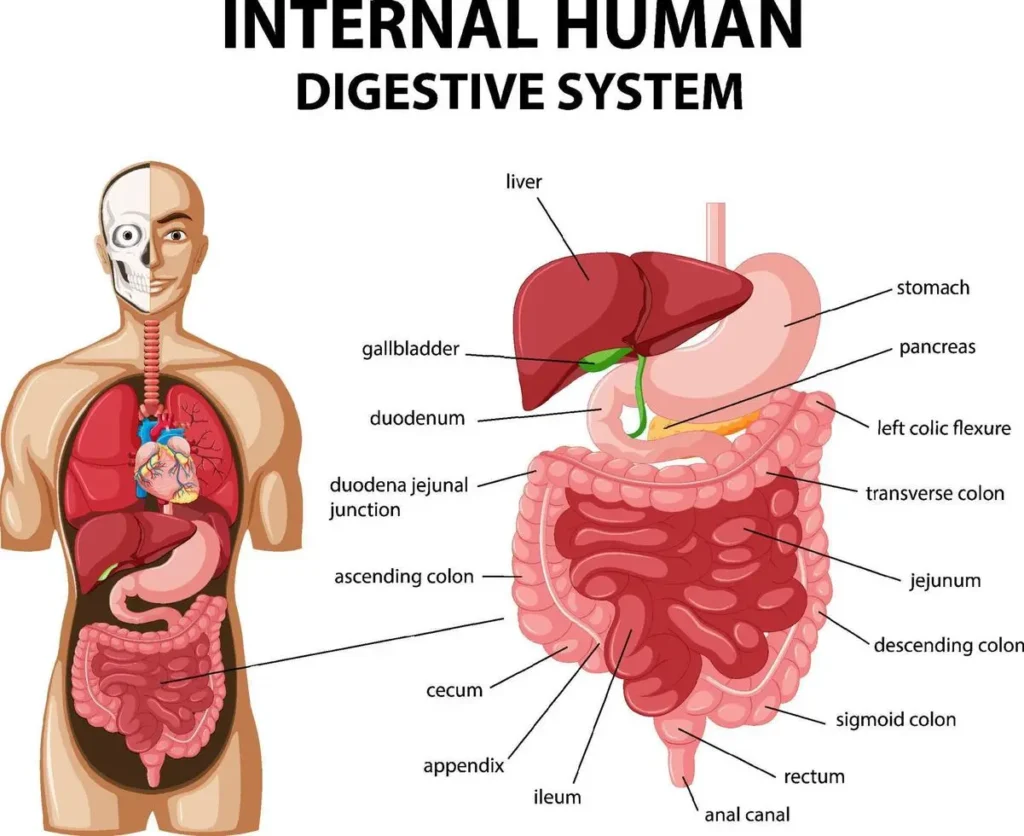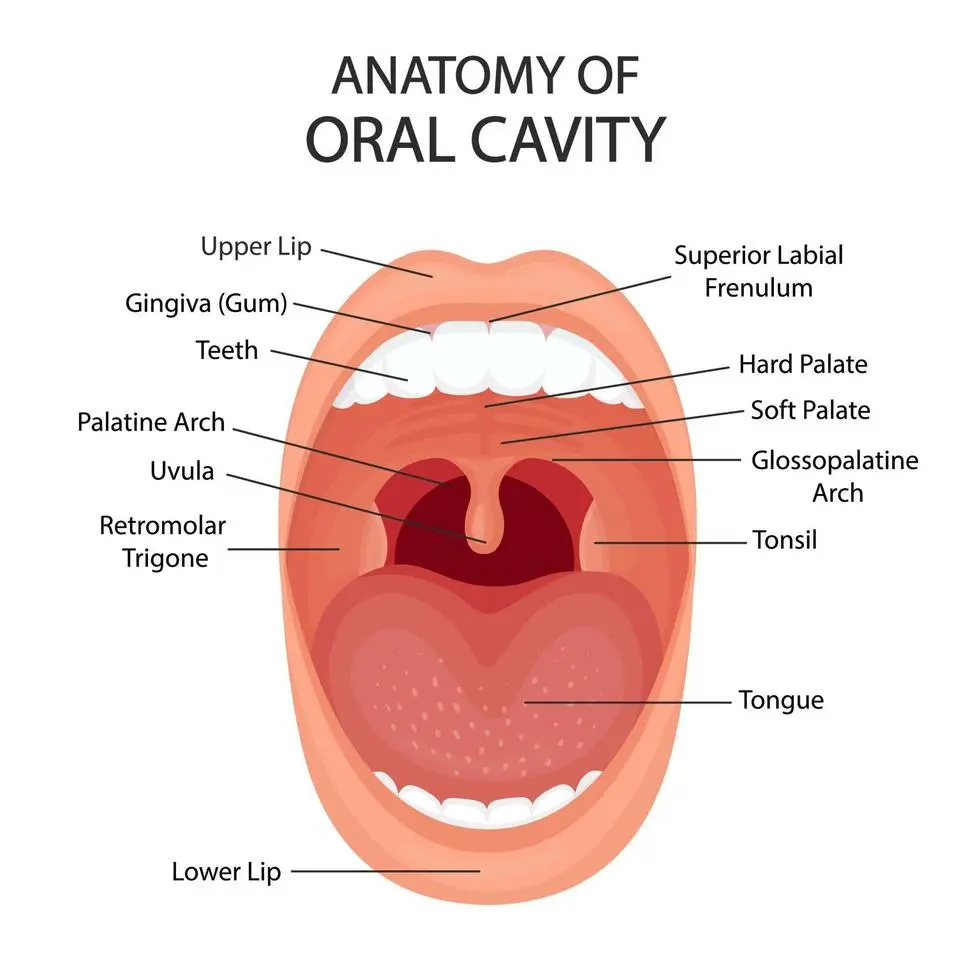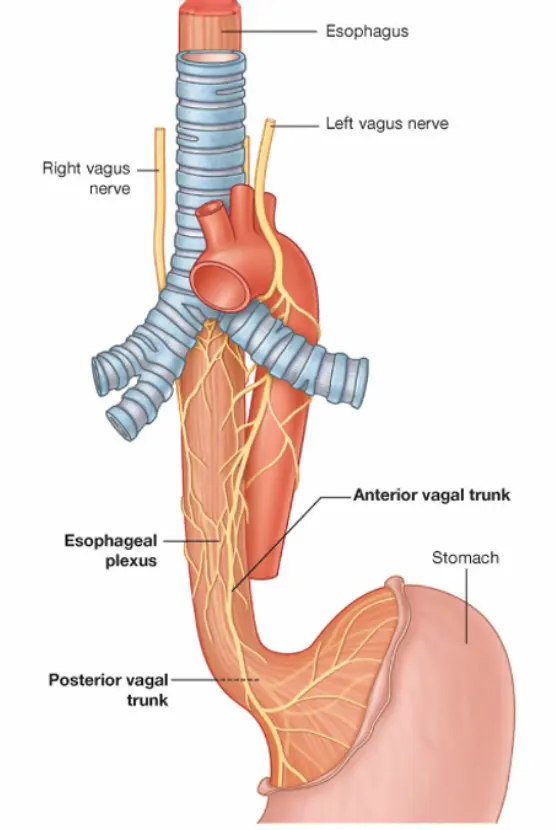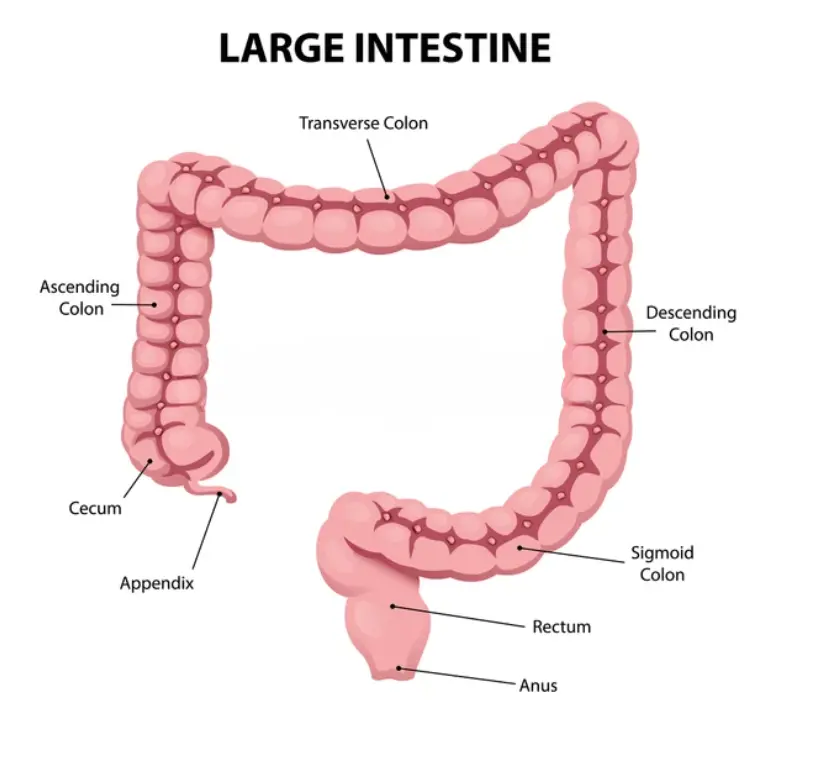
Table of Contents
Introduction to the Digestive System Labeled
The digestive system plays a crucial role in converting food into the energy and nutrients your body needs. Understanding how the digestive system works can help you better manage common digestive disorders and maintain optimal gut health. By exploring five key parts of the digestive system, this article will provide an in-depth look at how each part functions, along with labeled diagrams to visualize the process.
Throughout this article, we will include images of the Digestive System Labeled to provide a clear view of each key component. Additionally, we’ll share actionable tips to maintain digestive health and prevent disorders.
Introduction: Why You Should Understand the Digestive System
Digestive health is essential for overall well-being. When the digestive system functions properly, it efficiently breaks down food, absorbs nutrients, and eliminates waste. However, when any part of this system is disrupted, it can lead to common digestive disorders such as bloating, indigestion, constipation, or diarrhea.
By gaining a better understanding of the digestive process and its key components, you’ll be better equipped to maintain a healthy gut and address potential digestive issues before they become serious health concerns. This guide will walk you through the key organs involved in digestion: the mouth, esophagus, stomach, small intestine, and large intestine.
We will also cover how diet, hydration, exercise, and stress management can contribute to optimal digestive health.

1. Mouth: The Gateway to Digestion
The mouth is where digestion begins. Both mechanical and chemical processes occur here, preparing food for its journey through the digestive system.
Anatomy of the Mouth
Key components of the mouth involved in digestion include:
- Teeth: Chew food into smaller pieces, making it easier to swallow and digest.
- Tongue: Helps position food between the teeth for chewing and mixes it with saliva. The tongue also contains taste buds that detect the flavors of food.
- Salivary Glands: There are three major pairs of salivary glands in the mouth that produce saliva. Saliva not only moistens food but also contains the enzyme amylase, which begins the breakdown of carbohydrates.

How Food is Broken Down in the Mouth
When food enters the mouth, the teeth perform mechanical digestion by breaking food into smaller particles. Meanwhile, saliva secreted by the salivary glands begins chemical digestion. Saliva contains enzymes like amylase, which starts breaking down carbohydrates into simpler sugars. The more thoroughly food is chewed, the more effective digestion will be throughout the rest of the system.
Once the food is chewed, it is formed into a soft, moist ball called a bolus, which is then swallowed and travels down the esophagus.
Common Issues Related to the Mouth and Digestion
Poor oral hygiene, tooth decay, or gum disease can interfere with the initial stages of digestion. Problems such as cavities or missing teeth can reduce your ability to chew food properly, leading to larger food particles entering the stomach and intestines, potentially causing indigestion.
Additionally, conditions like dry mouth (xerostomia) can hinder the production of saliva, making it difficult to break down food and swallow.
Tip: Chew your food thoroughly—aim for at least 20-30 chews per bite to maximize digestion in the mouth. Avoid rushing through meals, as this can lead to improper digestion.
2. Esophagus: The Pathway to the Stomach
After food leaves the mouth, it enters the esophagus—a muscular tube that connects the throat to the stomach.
Anatomy and Structure of the Esophagus
The esophagus is a long, straight tube about 8-10 inches in length. Its upper part is connected to the pharynx, while its lower part connects to the stomach via the lower esophageal sphincter (LES). The LES opens to allow food into the stomach and closes to prevent the backflow of stomach acid.

How the Esophagus Works in Digestion
Once the bolus of food is swallowed, it enters the esophagus. The process of peristalsis, a series of wave-like muscle contractions, moves the food downward. Peristalsis is an involuntary process that occurs even if you’re lying down or eating upside down.
When the bolus reaches the end of the esophagus, the LES relaxes, allowing food to pass into the stomach. The LES then contracts to prevent stomach contents from refluxing back into the esophagus.
Common Esophageal Conditions
When the LES does not close properly, it can lead to acid reflux, where stomach acid moves back into the esophagus, causing heartburn. This is commonly associated with Gastroesophageal Reflux Disease (GERD).
Other conditions include esophageal ulcers and esophagitis, both of which can cause pain and difficulty swallowing.
Tip: Avoid large meals, particularly close to bedtime, as lying down soon after eating can increase the likelihood of acid reflux. Maintaining a healthy weight and avoiding trigger foods (e.g., fatty or spicy meals) can also help manage GERD.
3. Stomach: Breaking Down Food into Chyme
The stomach is the next stop for food and is responsible for continuing the digestive process by breaking down food into a semi-liquid substance called chyme.
Anatomy of the Stomach
The stomach is a J-shaped organ located between the esophagus and the small intestine. Its primary sections include:
- Cardia: The upper part where food enters from the esophagus.
- Fundus: The upper rounded portion that stores undigested food and gases.
- Body: The main section where most digestion occurs.
- Pylorus: The lower section that controls the passage of food into the small intestine.
The stomach is lined with a thick layer of mucus to protect it from the highly acidic gastric juices it produces.

How the Stomach Digests Food
When food reaches the stomach, it is mixed with gastric juices that contain hydrochloric acid and enzymes such as pepsin, which helps break down proteins. The stomach’s muscles contract to mix food with these digestive juices, a process known as churning. Over the next few hours, food is gradually transformed into chyme—a semi-liquid mixture of food and digestive enzymes.
Once the food is broken down into chyme, it is slowly released into the small intestine through the pyloric sphincter.
Common Stomach Disorders
Several conditions can affect the stomach, including:
- Gastritis: Inflammation of the stomach lining, often caused by infections (e.g., Helicobacter pylori), alcohol, or certain medications.
- Peptic Ulcers: Open sores that develop on the inner lining of the stomach or upper part of the small intestine.
- Acid Reflux: A condition in which stomach acid moves up into the esophagus, causing discomfort or heartburn.
Tip: Avoid excess consumption of alcohol and NSAIDs (non-steroidal anti-inflammatory drugs), both of which can irritate the stomach lining. Eating smaller, more frequent meals can also help prevent acid reflux and indigestion.
4. Small Intestine: The Main Site of Nutrient Absorption
The small intestine is where the majority of nutrient absorption occurs. After leaving the stomach, chyme enters the small intestine for further breakdown and absorption.
Anatomy of the Small Intestine
The small intestine is approximately 20 feet long and is divided into three main sections:
- Duodenum: The first part of the small intestine, where digestive juices from the liver and pancreas mix with chyme.
- Jejunum: The middle section, where most nutrients (e.g., carbohydrates, proteins, and fats) are absorbed.
- Ileum: The final section, which absorbs bile acids and vitamins such as vitamin B12.
The inner walls of the small intestine are lined with villi and microvilli—tiny finger-like projections that increase the surface area for nutrient absorption.

How the Small Intestine Absorbs Nutrients
In the small intestine, digestive enzymes from the pancreas and bile from the liver work together to break down fats, proteins, and carbohydrates. The villi and microvilli provide a large surface area for absorbing nutrients into the bloodstream.
Nutrients such as amino acids, simple sugars, fatty acids, and vitamins are absorbed through the walls of the small intestine and transported to various parts of the body for energy, growth, and repair.
Common Small Intestine Disorders
Several disorders can affect the small intestine, including:
- Celiac Disease: An autoimmune disorder where the ingestion of gluten damages the small intestine.
- Crohn’s Disease: A type of inflammatory bowel disease (IBD) that can affect any part of the digestive tract but is most commonly found in the small intestine.
- Lactose Intolerance: The inability to digest lactose, a sugar found in dairy products.
Tip: If you have conditions like celiac disease or lactose intolerance, avoid trigger foods such as gluten or dairy. Include gluten-free grains or lactose-free alternatives in your diet.
5. Large Intestine: Water Absorption and Waste Elimination
The large intestine, also known as the colon, is responsible for absorbing water and electrolytes from indigestible food matter and forming solid waste (stool).
Anatomy of the Large Intestine
The large intestine is about five feet long and includes the following sections:
- Cecum: The first part of the large intestine, where undigested food enters from the small intestine.
- Colon: The largest part of the large intestine, divided into ascending, transverse, descending, and sigmoid sections.
- Rectum: The final portion of the large intestine, where stool is stored before being expelled.
- Anus: The opening at the end of the digestive tract, where waste leaves the body.

How the Large Intestine Processes Waste
As food moves through the large intestine, water and salts are absorbed, and the remaining waste is formed into solid stool. Gut bacteria, also known as gut flora, play a vital role in breaking down fiber and producing certain vitamins (such as vitamin K and B vitamins).
The stool is then stored in the rectum until it is eliminated through a bowel movement. Regular bowel movements are a sign of a healthy large intestine.
Common Large Intestine Disorders
Common disorders that affect the large intestine include:
- Constipation: Difficulty in passing stool, often due to dehydration or lack of fiber in the diet.
- Irritable Bowel Syndrome (IBS): A condition characterized by abdominal pain, bloating, and changes in bowel habits (e.g., diarrhea or constipation).
- Colorectal Cancer: A form of cancer that starts in the colon or rectum. Regular screenings (e.g., colonoscopies) are key to early detection.
Tip: To maintain a healthy colon, consume a diet rich in fiber (e.g., fruits, vegetables, whole grains), stay hydrated, and engage in regular physical activity.
How to Support Digestive Health
Maintaining a healthy digestive system is essential for overall wellness, as it ensures your body can efficiently break down food, absorb nutrients, and eliminate waste. The digestive system is a complex network of organs that requires ongoing support at every stage of digestion, from the moment food enters your mouth to when it leaves your body. By adopting key lifestyle habits, you can optimize your digestive health and prevent common digestive disorders such as bloating, constipation, and indigestion.
Here are some practical, science-backed ways to support your digestive system:
1. Dietary Tips for Digestive Health
What you eat has a direct impact on the efficiency of your digestive system. A balanced diet rich in fiber, probiotics, and prebiotics can keep your digestive system functioning smoothly, while unhealthy or processed foods can lead to issues like constipation, gas, or even more serious digestive disorders.
Eat Fiber-Rich Foods
Fiber is essential for good digestion. It adds bulk to stool, making it easier to pass through the digestive tract and helping to prevent constipation. Moreover, fiber acts as food for the healthy bacteria that reside in your gut, promoting a balanced microbiome, which plays a crucial role in digestion, immune function, and even mood regulation.
There are two types of fiber:
- Soluble fiber: Dissolves in water and forms a gel-like substance that helps soften stool. It can be found in foods like oats, legumes, apples, and carrots.
- Insoluble fiber: Adds bulk to stool and helps food move through the digestive tract more quickly. Whole grains, nuts, and vegetables like cauliflower and green beans are good sources of insoluble fiber.
For optimal digestive health, include a mix of both soluble and insoluble fiber in your diet. Foods like whole grains, fresh fruits, vegetables, and legumes are excellent sources of dietary fiber that can help regulate bowel movements and prevent constipation.
Tip: Gradually increase your fiber intake to avoid gas or bloating, and pair it with plenty of water to aid in fiber’s movement through the digestive system.
Incorporate Probiotics and Prebiotics
Probiotics and prebiotics are essential for maintaining a healthy gut microbiome, which is the collection of beneficial bacteria in your digestive tract. A balanced gut microbiome helps break down food, synthesize vitamins, and protect against harmful pathogens.
- Probiotics: These are live beneficial bacteria that can be found in fermented foods such as yogurt, kefir, sauerkraut, kimchi, and miso. Probiotics help replenish the good bacteria in your gut, especially after taking antibiotics or when your gut flora is disrupted.
- Prebiotics: Prebiotics are a type of fiber that feeds the good bacteria in your gut, allowing them to thrive. They are found in foods like garlic, onions, bananas, asparagus, and whole grains.
Regularly incorporating both probiotics and prebiotics into your diet can promote a healthier gut environment, improve digestion, and may even help alleviate symptoms of digestive disorders like irritable bowel syndrome (IBS).
Tip: Start by adding probiotic-rich foods like yogurt or kefir into your daily routine, and combine them with prebiotic fibers found in whole plant-based foods to enhance their effectiveness.
2. Stay Hydrated
Hydration is crucial for maintaining digestive health, yet it is often overlooked. Water plays a fundamental role in breaking down food, ensuring nutrients are properly absorbed, and keeping the digestive system functioning smoothly.
Why Water is Essential for Digestion
Water helps dissolve fats and soluble fiber, allowing these nutrients to pass through your digestive tract more easily. It also helps keep the mucous membranes of the intestines moist, making digestion more efficient.
Dehydration can lead to constipation because it causes the colon to absorb more water from the stool, making it harder and more difficult to pass. On the other hand, staying hydrated ensures that stool remains soft and can move through the intestines with ease.
- Tip for Hydration: Aim for at least eight 8-ounce glasses of water per day, but more may be necessary depending on your activity level, climate, and overall health. If plain water feels monotonous, try adding a slice of lemon, cucumber, or mint for added flavor.
Additional Hydration Sources: Don’t rely solely on beverages; many foods, such as cucumbers, oranges, watermelon, and leafy greens, have high water content and can also contribute to your overall hydration.
3. Exercise Regularly
Physical activity isn’t just beneficial for your muscles and heart; it also plays an essential role in digestive health. Regular movement stimulates the natural contractions of the muscles in your intestines (called peristalsis), which helps move food through the digestive system and facilitates regular bowel movements.
How Exercise Promotes Digestion
Exercise increases blood flow to your digestive organs, ensuring they receive the oxygen and nutrients they need to function properly. Physical activity also helps prevent constipation by stimulating peristalsis, which encourages the movement of waste through your intestines.
Certain types of exercise can be particularly beneficial for digestion:
- Walking: A simple post-meal walk can aid digestion by speeding up the movement of food through your digestive tract. Just 15-20 minutes of walking after meals can significantly improve digestion.
- Yoga: Certain yoga poses, such as twists and stretches, can help relieve bloating and promote the movement of gas and waste through the intestines. Poses like “Seated Twist” and “Child’s Pose” can gently massage the digestive organs and support healthy digestion.
Incorporating regular exercise into your routine, such as a daily walk or moderate workout, can improve your overall digestive health by enhancing motility and preventing issues like constipation.
Tip: Aim for at least 30 minutes of moderate physical activity most days of the week. Even small bursts of activity, like taking the stairs or going for short walks, can have a positive effect on digestion.
4. Manage Stress
The connection between stress and digestion is undeniable. The gut-brain axis refers to the communication network that links your gut and brain. This connection explains why stress can cause digestive problems like bloating, diarrhea, and constipation. Chronic stress can also exacerbate conditions such as irritable bowel syndrome (IBS) and acid reflux.
How Stress Affects Digestion
When you’re stressed, your body goes into “fight or flight” mode, diverting blood and energy away from the digestive system. This slows down digestion, leading to symptoms like bloating, gas, or even indigestion. Prolonged stress can also alter the balance of gut bacteria, increasing the risk of digestive disorders.
Managing stress is essential for maintaining a healthy digestive system. Incorporating relaxation techniques into your daily routine can help reduce the impact of stress on your gut health.
Effective Stress-Management Techniques
- Mindfulness Meditation: Practicing mindfulness and meditation can help calm the nervous system, reduce stress, and, in turn, ease digestive discomfort. Even a few minutes of deep breathing each day can have a noticeable impact on your stress levels and digestion.
- Yoga and Deep Breathing: Yoga combines gentle movement with deep breathing, making it an effective practice for both stress reduction and digestion. Practicing yoga poses that focus on twisting and stretching the abdomen can also help alleviate gas and bloating.
- Sleep: A good night’s sleep is critical for digestive health. Lack of sleep can increase stress hormones, which can disrupt digestion and lead to constipation, bloating, or acid reflux. Aim for 7-9 hours of quality sleep each night.
Tip: If you find yourself stressed or overwhelmed, take a few minutes to practice deep breathing exercises or mindfulness meditation. Slowing down your breath and calming your mind can help reset your digestive system and reduce discomfort.
Conclusion: Understanding and Caring for Your Digestive System
The digestive system is a complex but highly coordinated system. Each part—from the mouth to the large intestine—plays a vital role in processing food, absorbing nutrients, and eliminating waste. By understanding how these organs work together, you can take steps to maintain a healthy digestive system and prevent common issues.
With habits like eating a fiber-rich diet, drinking plenty of water, exercising regularly, and managing stress, you can support your digestive health and improve your overall well-being. When problems arise, early detection and treatment can prevent more serious health complications.
FAQs About the Digestive System
Q1: What causes bloating after eating?
Bloating can result from overeating, eating too quickly, or consuming gas-producing foods like beans, broccoli, and carbonated drinks. Food intolerances (such as lactose or gluten intolerance) can also contribute to bloating.
Q2: How does exercise help digestion?
Regular exercise stimulates intestinal contractions, which help move food through the digestive tract more efficiently. This can prevent constipation and improve overall digestion.
Q3: Can drinking water during meals affect digestion?
Drinking water during meals helps soften food and aids digestion. However, excessive water during meals can dilute stomach acid, which may slow down digestion. It’s best to drink moderate amounts with meals and more between meals.
Q4: How do probiotics support digestion?
Probiotics are beneficial bacteria that help balance gut flora, improve digestion, and prevent conditions like diarrhea, constipation, and irritable bowel syndrome (IBS). Fermented foods like yogurt and kefir are great sources of probiotics.
Q5: What is the role of fiber in digestion?
Fiber adds bulk to stool and helps regulate bowel movements. Soluble fiber also feeds beneficial gut bacteria, supporting overall digestive health.